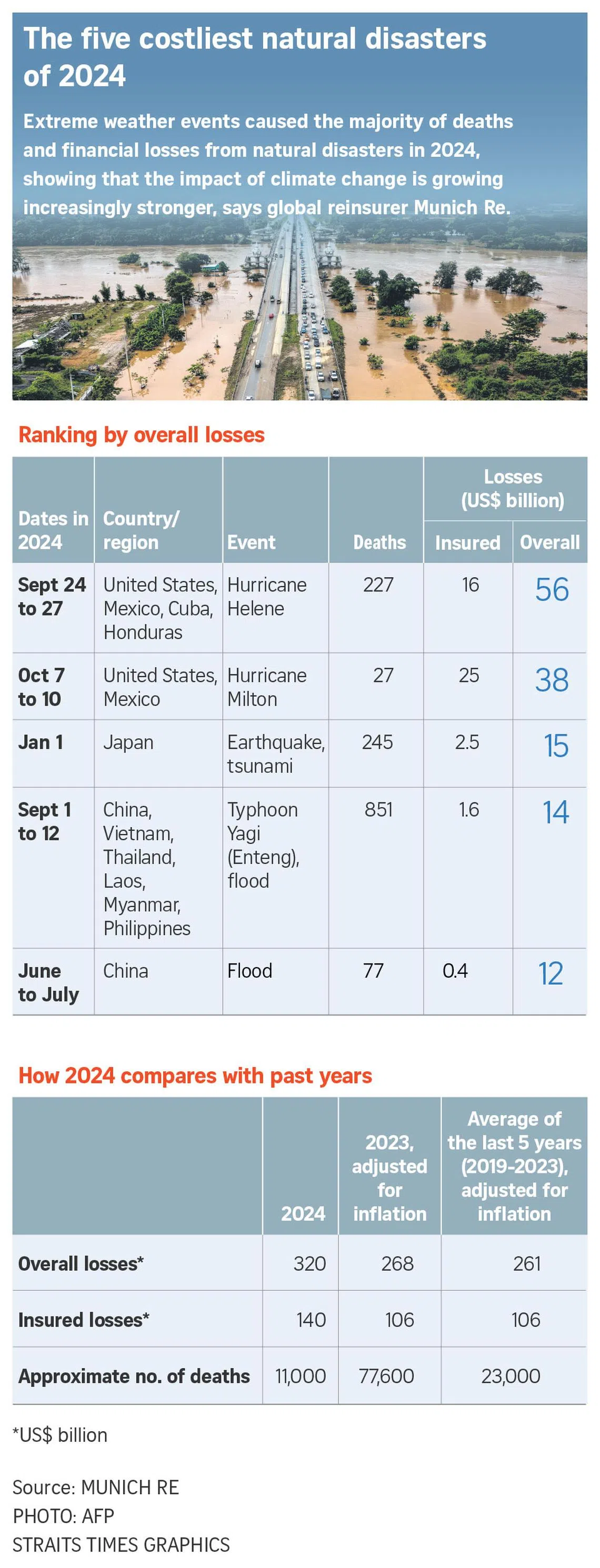Climate change ‘showing its claws’ as disaster damage bill soars to $438b in 2024
Sign up now: Get ST's newsletters delivered to your inbox

Firefighters pump out the floodwater out of a tunnel where vehicles are piled up, after heavy rains in Alfafar, in Valencia, Spain, on Nov 1, 2024.
PHOTO: REUTERS
Follow topic:
SINGAPORE - Natural disasters caused US$320 billion (S$438.6 billion) in overall losses in 2024, as climate change fuels increasingly more destructive weather around the globe, reinsurance giant Munich Re said on Jan 9.
Insured losses from such disasters – including deadly tropical cyclones, floods and earthquakes – totalled US$140 billion globally. This makes 2024 the third most expensive year for the industry since 1980, Munich Re said in its annual natural catastrophe report.
Reinsurers like Munich Re provide insurance to insurance companies, thereby spreading the risk.
Weather catastrophes, supercharged by a warming atmosphere and oceans, were responsible for 93 per cent of overall losses and 97 per cent of insured losses, it said.
The disasters in 2024 also killed about 11,000 people, compared with the annual average of 17,500 for the past decade (2014 to 2023), and left a US$180 billion damage bill not covered by insurance.
“Climate change is showing its claws with its destructive forces becoming increasingly evident. It plays a crucial role in making weather disasters more frequent and more extreme,” said Munich Re’s chief climate scientist Tobias Grimm.
“Our planet’s weather machine is shifting to a higher gear,” he told The Straits Times.
In Asia, the costliest disasters in 2024 were the New Year’s Day earthquake in Japan (245 deaths, US$15 billion in overall losses); and Typhoon Yagi, which struck the Philippines, China, Vietnam and several other countries in September (851 deaths, US$14 billion in losses).
Flooding in China between June and July 2024 killed 77 people and caused US$12 billion in overall losses, of which only US$400 million was insured.
The world’s costliest disasters in 2024 were Hurricanes Helene and Milton between September and October 2024 – these killed 254 people and caused overall losses of US$94 billion, of which US$41 billion was insured.
Most of the deaths and losses from both storms were in the US.

Tornadoes, hail storms, wildfires and floods also took a heavy toll globally.
Record flooding in Spain in October 2024 killed 229 people and caused US$11 billion in losses, less than half of which was insured.
“Societies need to prepare for more severe weather catastrophes,” Dr Thomas Blunck, a member of Munich Re’s board of management, said in the report.
Scientists now have a much better understanding of the link between climate change and individual weather events.
The science of climate attribution can determine to what extent climate change contributed to a specific event. This helps the insurance industry better prepare for a riskier future.

Nearly a month after severe flooding, a person walks past a field where water-ravaged cars are piled up in Paiporta, Valencia, on Nov 28.
PHOTO: REUTERS
For instance, studies in 2024 by World Weather Attribution (WWA), an international scientific collaboration, found that climate change, which is being largely fuelled by the heat-trapping emissions from burning fossil fuels, intensified the winds and rainfall from Hurricanes Helene and Milton.
For Helene, climate change increased rainfall by about 10 per cent, and it also made the storm’s winds about 21kmh, or 11 per cent, more intense.
For the floods in Spain, WWA said climate change made the extreme rainfall about 12 per cent heavier and twice as likely to have occurred, compared with a world without man-made global warming.
WWA uses weather observations and climate models to understand how climate change influences the intensity and likelihood of extreme weather events.
The Munich Re report also highlights the risk of increasingly costly disasters and the price of coverage, especially in poorer nations and for people living in places at growing risk of repeat disasters, such as floods and wildfires.
“You cannot deny the ever-increasing losses caused by natural disasters affect the price for insurance cover. But prices must reflect the risk in order to maintain the balance between payouts and premiums,” Mr Grimm told ST.
“When losses go up, prices are very unlikely to go down. In some regions, affordability is already a major problem today. Improving how and where homes and businesses are built can reduce potential future losses, which in turn lowers the risk. More prevention is key to keeping premiums affordable,” he said.
Early-warning systems can help, especially in reducing lives lost, he said. But much more needs to be done.
“There is still a tendency in politics to provide financial aid after disasters (occur), instead of investing in preventive measures before disasters happen,” said Mr Grimm.
“Everyone pays the price for worsening weather extremes, but especially the people in countries with little insurance protection or publicly funded support to help with recovery,” he added.
David Fogarty is deputy foreign editor at The Straits Times and senior climate writer. He also covers the environment, in areas ranging from biodiversity to plastic pollution.


